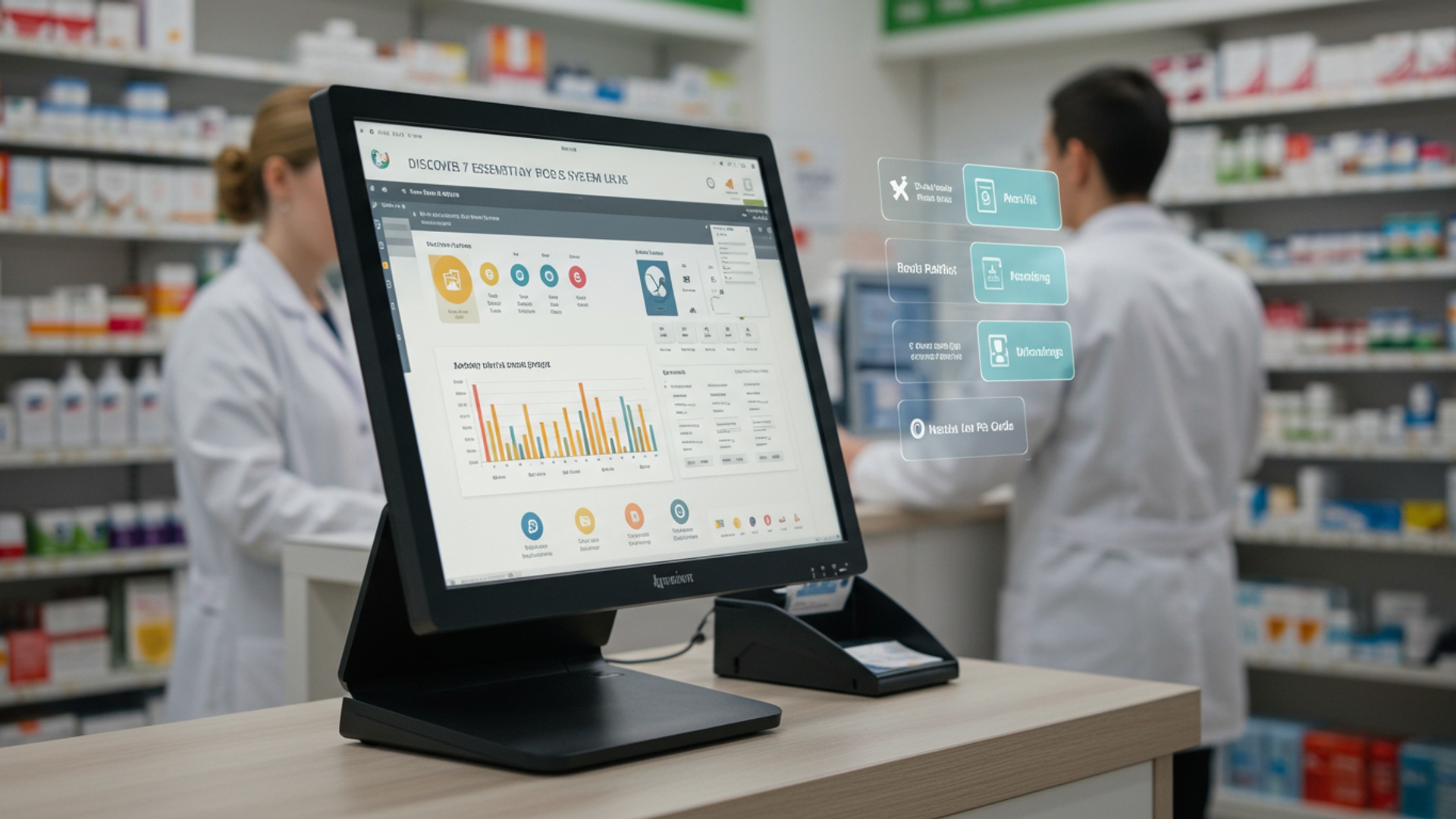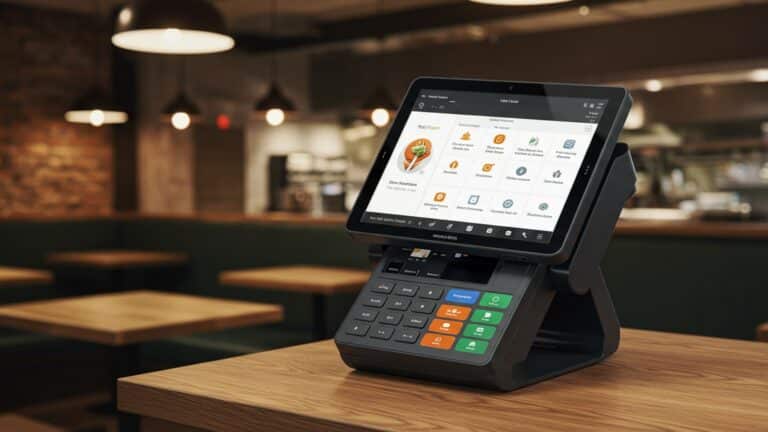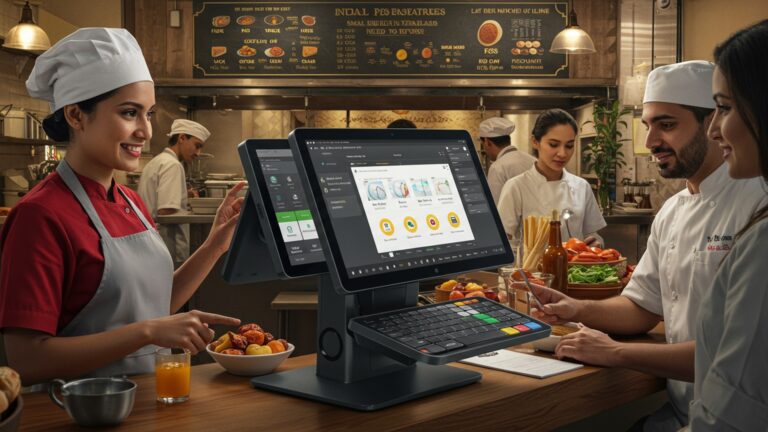Discover 7 Essential Benefits of a Modern Pharmacy POS System Guide
In today’s rapidly evolving healthcare landscape, pharmacies navigate unprecedented pressures, from complex regulatory compliance like 340B programs to soaring patient expectations for swift, personalized service. A robust, modern pharmacy POS system is no longer a mere transaction tool but a strategic imperative, transforming daily operations into a powerhouse of efficiency and patient-centric care. This advanced technology directly addresses critical challenges, facilitating intricate inventory management with real-time data, streamlining prescription fulfillment. enhancing patient engagement through integrated loyalty programs and communication tools. It empowers pharmacies to optimize workflows, leverage data analytics for better decision-making. free up valuable staff time for crucial patient consultations, reflecting a recent industry shift towards value-based care models.

1. Revolutionizing Inventory Management and Loss Prevention
A modern pharmacy POS system is instrumental in transforming how pharmacies manage their inventory, moving beyond manual, error-prone processes to a sophisticated, data-driven approach. At its core, a Point of Sale (POS) system is a software and hardware solution that processes transactions. in a pharmacy context, its capabilities extend far beyond simple sales. With an advanced pharmacy POS system, pharmacists can achieve granular control over their stock. This includes real-time tracking of every item from the moment it enters the store to when it leaves, whether through sale, return, or spoilage. This level of detail is critical for several reasons:
- Minimizing Stockouts and Overstock
- Expiration Date Management
- Controlled Substance Tracking
- Automated Reordering
By providing accurate, up-to-the-minute data on inventory levels, the system helps identify fast-moving products that need frequent reordering and slow-moving items that might be tying up capital. This predictive capability prevents both frustrating stockouts for patients and costly overstocking for the pharmacy.
Medications have strict expiration dates. A robust pharmacy POS system can flag items nearing expiration, allowing pharmacists to implement strategies like “first-in, first-out” (FIFO) to reduce waste and ensure patient safety. Some systems even integrate with supplier databases to automatically update product insights, including expiration details.
This is perhaps one of the most vital features. Modern POS systems provide an unalterable audit trail for controlled substances, meticulously documenting every step from receipt to dispensation. This feature is not just about efficiency; it’s a critical tool for regulatory compliance and preventing diversion, an issue that carries severe legal and ethical ramifications. For instance, the system can track lot numbers, serial numbers. specific patient details for each controlled substance dispensed, providing a comprehensive log for DEA audits.
Based on sales data and pre-set thresholds, the system can automatically generate purchase orders, reducing administrative burden and ensuring optimal stock levels without constant manual oversight.
Consider a real-world scenario: A busy urban pharmacy struggling with frequent stockouts of a popular allergy medication and an abundance of a less common supplement. Before implementing a modern pharmacy POS system, their inventory was managed via spreadsheets, leading to reactive ordering. After integrating the POS, they could review sales trends, set minimum reorder points. automatically generate purchase orders. This not only ensured they always had the allergy medication in stock but also allowed them to liquidate the overstocked supplement through targeted promotions, freeing up capital.
Invest in a pharmacy POS system that offers comprehensive inventory modules, including expiration date tracking and robust controlled substance management. Regularly review inventory reports to optimize stock levels and reduce waste.
2. Streamlining Sales and Enhancing Checkout Efficiency
The checkout experience is often the primary touchpoint for patients. a smooth, efficient process can significantly enhance satisfaction and operational flow. A modern pharmacy POS system is designed to optimize this critical juncture, transforming it from a potential bottleneck into a seamless interaction. Key benefits include:
- Faster Transaction Processing
- Accurate Pricing and Promotion Management
- Integrated Payment Processing
- Prescription Co-Pay and Insurance Integration
With intuitive interfaces and integrated barcode scanners, pharmacists and technicians can quickly process sales, look up product insights. apply discounts. This dramatically reduces patient wait times, which is a major contributor to patient satisfaction in a healthcare setting.
The system ensures that all products are priced correctly, automatically applying any current promotions, discounts, or loyalty program benefits. This eliminates manual errors, prevents pricing disputes. maintains consistency across all transactions. For instance, if a specific brand of vitamins is on a “buy one, get one half off” promotion, the pharmacy POS system applies this automatically at checkout.
Modern systems offer seamless integration with various payment methods, including credit/debit cards, mobile payments (e. g. , Apple Pay, Google Pay). flexible spending accounts (FSAs) or health savings accounts (HSAs). This not only speeds up transactions but also reduces the risk of human error associated with manual entry and enhances security by encrypting payment data.
A standout feature for pharmacies is the ability of the POS to integrate with insurance verification systems. This allows for real-time calculation of patient co-pays, streamlining the complex process of insurance claims and reducing the administrative burden on staff. It also provides transparency to patients regarding their out-of-pocket costs upfront.
A prime example is a suburban pharmacy that used an outdated cash register and separate credit card terminal. Each transaction involved manually entering prices, calculating discounts. then swiping cards on a disconnected machine. This led to long queues during peak hours. After implementing a new pharmacy POS system, they saw a 30% reduction in average transaction time, significantly improving patient flow and reducing staff stress. Patients appreciated the faster service and the clear breakdown of their co-pays directly on their receipts.
Prioritize a pharmacy POS system with integrated payment processing and real-time insurance verification to create a fast, accurate. transparent checkout experience for your patients.
3. Optimizing Prescription Management and Patient Safety
The core function of any pharmacy revolves around accurate and safe prescription dispensing. A modern pharmacy POS system is a powerful ally in this mission, integrating seamlessly with various pharmacy workflows to enhance patient safety, compliance. overall efficiency. Here’s how it elevates prescription management:
- Integrated Patient Profiles and Medication History
- E-Prescribing Integration
- Refill Reminders and Adherence Programs
- Workflow Automation and Dispensing Accuracy
Beyond basic contact data, a sophisticated pharmacy POS system maintains comprehensive patient profiles. This includes medication history, known allergies, chronic conditions. even preferred communication methods. This centralized data allows pharmacists to quickly identify potential drug-drug interactions or contraindications before dispensing, significantly enhancing patient safety. For example, if a patient is prescribed a new medication that interacts with an existing one, the system can flag this immediately.
Direct integration with e-prescribing platforms (like Surescripts in the U. S.) allows pharmacies to receive prescriptions electronically, reducing errors associated with handwritten scripts, improving legibility. speeding up the intake process. The POS system can automatically populate patient and prescription details, minimizing manual data entry.
A key aspect of patient care is medication adherence. Modern POS systems can automate refill reminders via SMS, email, or integrated patient portals. This proactive approach helps patients stay on schedule with their medications, improving health outcomes and fostering loyalty. Pharmacists can also track adherence patterns, identifying patients who might need additional counseling or intervention.
From prescription intake to verification and dispensing, the pharmacy POS system can guide staff through a structured workflow. It can incorporate barcode scanning for prescription labels and medication bottles to ensure the “5 Rights” of medication administration (right patient, right drug, right dose, right route, right time), drastically reducing dispensing errors.
Consider a scenario where a patient with multiple chronic conditions receives prescriptions from several specialists. Without an integrated system, a pharmacist might not easily spot a potential overlap or interaction. With a modern pharmacy POS system, all medication history is aggregated. the system performs automated checks against new prescriptions, alerting the pharmacist to any red flags. This not only protects the patient but also safeguards the pharmacy from potential liabilities.
Prioritize a pharmacy POS system with robust e-prescribing integration, comprehensive patient profiles. automated refill reminders to enhance patient safety and improve medication adherence.
4. Fostering Patient Engagement and Building Stronger Relationships
In today’s competitive healthcare landscape, patient relationships are paramount. A modern pharmacy POS system is no longer just a transaction tool; it’s a powerful customer relationship management (CRM) platform that enables pharmacies to build deeper connections and foster loyalty. Here’s how a pharmacy POS system can elevate patient engagement:
- Personalized Communication and Outreach
- Loyalty Programs and Rewards
- Comprehensive Patient Data Management
- Feedback Mechanisms
By leveraging the patient data stored within the POS, pharmacies can segment their patient base and send targeted communications. This could include personalized health tips, vaccine reminders, or details about new services relevant to their specific conditions. For example, patients with diabetes might receive an email about new diabetic supplies or educational workshops.
Integrated loyalty programs within the pharmacy POS system allow pharmacies to reward repeat business. Patients can earn points for purchases, receive exclusive discounts, or access special services. This incentivizes continued engagement and makes patients feel valued. The system can automatically track points, manage rewards. apply them at checkout, making the process seamless for both staff and patients.
Beyond prescription history, the POS can store preferences (e. g. , preferred generic vs. brand, communication method), notes from pharmacist consultations. even insurance details. This holistic view allows staff to provide a more personalized and empathetic service experience.
Some advanced POS systems integrate with patient feedback tools, allowing pharmacies to solicit reviews or conduct short surveys after a visit. This direct feedback is invaluable for identifying areas for improvement and demonstrating a commitment to patient satisfaction.
Consider a community pharmacy that implements a loyalty program through its new pharmacy POS system. Patients accrue points for every prescription and over-the-counter purchase. Once they reach a certain threshold, they receive a discount on their next non-prescription purchase or access to a free health screening. This not only encourages repeat visits but also provides valuable data on patient purchasing habits, allowing the pharmacy to tailor its offerings and marketing efforts more effectively. One pharmacy reported a 15% increase in repeat customers after launching such a program.
Utilize your pharmacy POS system‘s capabilities for personalized communication and integrated loyalty programs to build stronger patient relationships and drive repeat business.
5. Unlocking Insights with Robust Reporting and Analytics
Data is the new currency. for pharmacies, understanding operational and sales data is crucial for strategic decision-making and sustainable growth. A modern pharmacy POS system is an invaluable tool for generating insightful reports and analytics, transforming raw data into actionable intelligence. Key reporting capabilities include:
- Sales Performance Reports
- Inventory Turnover and Profitability Analysis
- Patient Demographics and Purchasing Patterns
- Staff Performance Metrics
- Financial Reconciliation
These reports provide a detailed breakdown of sales by product, category, time of day, staff member. even payment method. Pharmacists can identify peak sales periods, best-selling items. underperforming products. This data is essential for optimizing staffing schedules, merchandising. inventory levels.
Beyond just tracking stock, the POS system can generate reports on inventory turnover rates, identifying which products are moving quickly and which are sitting on shelves. It can also calculate profit margins per product, helping the pharmacy optimize its purchasing strategies and pricing.
By analyzing patient data, pharmacies can gain insights into their primary demographic, common health needs. purchasing habits. This insights can inform targeted marketing campaigns, the introduction of new services (e. g. , specialized clinics), or adjustments to product offerings.
Some systems can track individual staff performance, such as average transaction time, sales per hour, or error rates. This data can be used for training, performance reviews. recognizing top performers, ultimately improving overall service quality.
The pharmacy POS system simplifies end-of-day and end-of-month reconciliation by providing accurate sales totals, payment breakdowns. tax reports, making accounting processes more efficient and reducing discrepancies.
Imagine a pharmacy owner who notices a consistent dip in sales during Tuesday afternoons. By running a sales report through their pharmacy POS system, they discover that this period also coincides with lower foot traffic and a reduced number of prescription pickups. Armed with this data, they decide to offer a “Wellness Wednesday” discount on over-the-counter products, starting late Tuesday, to attract more customers and boost sales during the slower period. This data-driven decision turns a weakness into an opportunity.
Regularly leverage the reporting and analytics features of your pharmacy POS system to identify trends, optimize operations. make informed business decisions that drive profitability and patient satisfaction.
6. Ensuring Regulatory Compliance and Bolstering Security
Pharmacies operate in one of the most heavily regulated industries, with strict guidelines governing patient privacy, medication dispensing. financial transactions. A modern pharmacy POS system is not just a convenience; it’s a crucial tool for maintaining compliance and safeguarding sensitive data. Key aspects of compliance and security include:
- HIPAA Compliance
- Controlled Substance Tracking and Auditing
- Audit Trails and User Accountability
- Payment Card Industry Data Security Standard (PCI DSS) Compliance
- Data Backup and Disaster Recovery
The Health Insurance Portability and Accountability Act (HIPAA) mandates strict rules for protecting Protected Health details (PHI). A robust pharmacy POS system helps pharmacies comply by implementing features like secure patient data storage, access controls (limiting who can view specific details). audit trails that record every access and modification to patient records. Data encryption, both in transit and at rest, is a standard security measure.
As mentioned previously, the meticulous tracking of controlled substances is a non-negotiable requirement by agencies like the DEA. The POS system provides an immutable log of every transaction involving these medications, including dispenser, patient, date. quantity. This electronic record simplifies audits and significantly reduces the risk of diversion or errors.
Every action taken within the pharmacy POS system, from processing a sale to modifying an inventory count, is typically logged with a timestamp and the user’s identification. This creates a comprehensive audit trail, crucial for investigating discrepancies, ensuring accountability. proving compliance during regulatory inspections.
For processing credit card payments, pharmacies must adhere to PCI DSS. Modern POS systems are designed with this in mind, often featuring end-to-end encryption for payment data, tokenization. secure network architecture to protect cardholder data from breaches.
Cloud-based pharmacy POS system solutions offer automated data backup, ensuring that critical patient and business data is secure even in the event of hardware failure or a local disaster. This is essential for business continuity and regulatory mandates for data retention.
Consider a pharmacy that faces a sudden DEA audit regarding its controlled substance inventory. Without a sophisticated pharmacy POS system, manually retrieving years of paper records and matching them to dispense logs would be an arduous, time-consuming. error-prone task. With a compliant POS system, the pharmacy can generate detailed, verifiable reports instantly, demonstrating their adherence to strict regulations and avoiding potential fines or sanctions.
Select a pharmacy POS system that explicitly states its adherence to HIPAA, PCI DSS. offers robust features for controlled substance tracking and comprehensive audit trails to ensure legal compliance and data security.
7. Driving Operational Efficiency and Reducing Costs
Beyond the direct benefits to sales and patient care, a modern pharmacy POS system fundamentally transforms the operational backbone of a pharmacy, leading to significant efficiencies and tangible cost savings. By automating routine tasks and providing critical insights, it frees up valuable staff time and optimizes resource allocation. Here’s how a pharmacy POS system enhances operational efficiency and reduces costs:
- Automation of Manual Tasks
- Reduced Errors and Shrinkage
- Optimized Staffing
- Better Purchasing Decisions
- Integration with Other Systems
Many administrative tasks that traditionally consumed considerable staff time—such as manual inventory counts, price updates, reordering. end-of-day reconciliations—are automated by the POS system. This automation reduces human error and allows staff to focus on higher-value activities, like patient counseling or clinical services.
Automated pricing, barcode scanning for prescriptions and inventory. streamlined workflows significantly reduce dispensing errors, pricing mistakes. inventory discrepancies (shrinkage). Each error prevented translates directly into saved time, reduced product loss. avoidance of potential legal liabilities.
With faster transaction processing and automated workflows, pharmacies can often handle higher patient volumes with existing staff or even optimize staffing levels during slower periods. The data from the POS system can also help in scheduling staff more effectively based on peak hours and workload.
The detailed reporting on sales, inventory turnover. product profitability enables pharmacists to make smarter purchasing decisions. They can negotiate better deals with suppliers based on accurate volume data, avoid purchasing slow-moving or expired stock. optimize their product mix to maximize profit margins. This directly impacts the pharmacy’s bottom line.
A modern pharmacy POS system often integrates with other crucial pharmacy software, such as pharmacy management systems (PMS), wholesaler ordering platforms. accounting software. This seamless data flow eliminates redundant data entry, improves data accuracy across systems. creates a unified operational ecosystem.
Consider a small independent pharmacy where the owner spent several hours each week manually reconciling sales, updating inventory spreadsheets. preparing reorder lists. After implementing an integrated pharmacy POS system, these tasks were largely automated. The owner now dedicates that freed-up time to expand clinical services, such as medication therapy management, which not only generates new revenue streams but also enhances the pharmacy’s reputation as a healthcare hub. The initial investment in the POS system quickly paid for itself through reduced labor costs, minimized waste. increased service offerings.
Evaluate a pharmacy POS system not just on its features. on its capacity to automate manual tasks, reduce errors. integrate with your existing technology stack to drive significant operational efficiencies and long-term cost savings.
Conclusion
We’ve thoroughly explored how a modern pharmacy POS system transcends basic transaction processing, becoming a strategic cornerstone for operational efficiency, enhanced patient care. sustainable growth. Imagine the impact of real-time inventory insights, for instance, preventing critical medication stockouts – a specific example of how technology directly safeguards patient well-being and improves workflow accuracy. In my view, pharmacies that prioritize these integrated solutions are not merely keeping pace. truly setting new standards for patient experience in a rapidly evolving healthcare landscape, especially with the rise of digital health integration. My personal tip? Don’t just compare features; envision how each benefit, like faster checkout or streamlined prescription management, directly impacts your daily operations and, crucially, your patients’ perception of your service. The journey to a modernized pharmacy begins with a single, informed decision. Embrace the power of a cutting-edge POS; it’s not just an upgrade, it’s an investment in your pharmacy’s future resilience and success. Take that definitive step to transform your business today.
More Articles
7 Essential Features to Choose the Best Pharmacy POS Software
5 Essential Pharmacy Management Software Benefits You Need to Know
How to Choose and Implement Cloud Based POS Software for Your Business
How to Select the Best POS Software in India A Comprehensive Guide
Learn How to Master POS Billing Software for Faster Sales and Efficiency
FAQs
What exactly is a modern pharmacy POS system, anyway?
It’s more than just a cash register! A modern pharmacy POS (Point of Sale) system is a comprehensive software solution designed specifically for pharmacies. It integrates various functions like sales, inventory management, prescription processing. customer relationship management to streamline operations and improve patient service.
Why should my pharmacy consider upgrading to a new POS system?
Upgrading brings a ton of advantages. You’ll see improvements in efficiency, better control over your inventory, enhanced patient safety, quicker transaction times. access to valuable data that can help you make smarter business decisions. It’s all about modernizing your entire workflow.
How does a modern POS system help manage inventory more effectively?
It’s a game-changer for inventory! These systems provide real-time tracking of medications and products, automate reordering based on sales data, reduce waste from expired stock. help you identify slow-moving items. This means you always have what your patients need without overstocking.
Can a new POS system really boost my pharmacy’s efficiency?
Absolutely! By automating tasks like sales processing, prescription filling. billing, a modern POS system frees up your staff’s time. This allows them to focus more on patient consultations and other critical tasks, reducing wait times and improving overall service speed.
What benefits does it offer for patient safety and care?
Patient safety is paramount. A modern POS system can integrate with prescription management, flag potential drug interactions, manage patient profiles with allergy insights. ensure accurate labeling. This reduces errors and provides a more personalized and safer experience for your patients.
Does a modern pharmacy POS system help with financial aspects or reporting?
Definitely. These systems can generate detailed sales reports, track revenue, manage billing. even integrate with accounting software. This gives you clear insights into your pharmacy’s financial performance, making budgeting and financial planning much easier and more accurate.
How does having a modern POS system help my pharmacy stay competitive?
In today’s market, efficiency and excellent service are key. A modern POS system helps you deliver both by speeding up transactions, personalizing patient interactions. offering services like loyalty programs. This not only keeps your current patients happy but also attracts new ones, giving you an edge over competitors.




